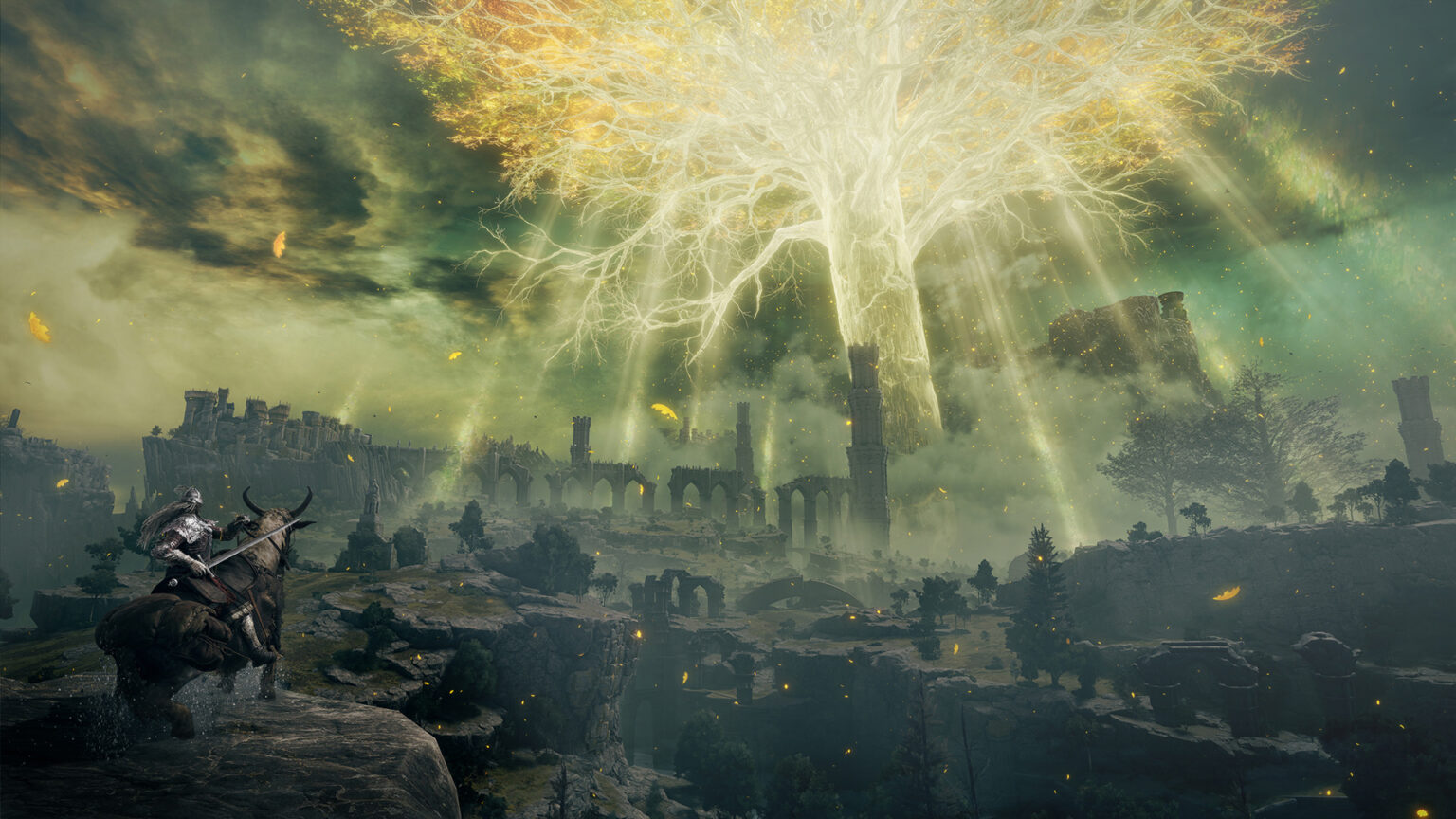Despite shaking up the Souls formula with an open world, From Software’s next adventure, Elden Ring, will remain true to the core mantra of the series, namely exceptionally difficult combat. The grueling difficulty of From Software games is what usually holds me back from either trying or continuing a Soul’s game, but something about Elden Ring is pulling me in. Even though I’ve only dabbled in From Software games, Elden Ring’s smart design choices are appealing in that they boast a surprisingly welcome invite to an otherwise, intimidating world. Despite not being able to play Elden Ring for myself, I watched several people play through the network test and pinpointed specific details that pulled me in.
However, before I get into specifics, it might be helpful to explain where I’m coming from. Most people feel the same way as I do: there’s a pull to enter this genre, but inventory management, constant trial and error, and a dedicated fanbase are too intimidating. Also, like me, you‘ve probably tried your hand at the genre at least once. I did manage to play Bloodborne, mostly through a sense of obligation to my PlayStation fandom, though I never felt like I beat it with my own skill. I requested help from much more experienced players, basically staying in the corner and sending everyone out to do my dirty work.
I realized, after “beating” Bloodborne, that the sense of accomplishment and reward was unlike anything else out there, the main drawing point for fans. There is no illusion of progress, but rather a culmination of skills that bring you to success. After getting defeated by a boss, you learn something about their attack pattern, until eventually, you have the system down and can succeed. Still, I was not motivated to learn through suffering, so Bloodborne was my last From Software game for a while.
After Demon’s Souls came out, I gave it a shot, mainly to bolster my PlayStation 5 launch library, and quickly discovered that my knight was too slow. After sifting through my inventory and taking off most of my armor, the character still seemed rather cumbersome. By that point, I kept on getting burnt alive by a giant spider, and just decided to call it quits. Despite all the hype surrounding Elden Ring, I was confident I wouldn’t try my hand at another From Software game.
I was proven wrong. Now I’m anxious to pick up Elden Ring and try, once again, to get into the From Software grove once and for all.
The Open World
This first point may seem rather obvious since an open world is the biggest advancement Elden Ring brings to the From Software formula, but freedom creates an accessible and welcoming alternative to difficulty. Also, I’m not the biggest fan of the industry’s general fascination with open worlds, but for some games, it simply makes sense. Previously, From Software games shared a rather linear path with some optional bosses and various shortcuts along the way.
This meant that sometimes, progression was blocked by a difficult foe with no means of getting around them. This moment halts many newcomers, including me, from ever progressing in a Soul’s game. These scenarios leave you with limited options, including retrying the boss countless times or going to a previous part of the map to farm souls, gear, or healing potions.
In Elden Ring, the options for getting around a difficult foe are much more lenient. There are two different boss encounters in Elden Ring, including a Foe, mini-bosses, and Great Foes, who resemble the traditional From Software boss fight. For either type, if the enemy proves to be more than you can handle, the open-world gives you several other things to do instead of endlessly suffering against the same boss. Of course, the boss will be waiting for you to return, but this time you’ll be confident and prepared.
This is best explained through a boss that trots around near the beginning of the network test. The Tree Sentinal is a giant knight adorning shiny gold armor who rides a horse of equally intimidating size. The foe is admirable in strength and might be the first boss encounter for new players, which will, in almost every circumstance, result in death. In the past, if you realized you’re not ready to face such a strong enemy, you back peddle through linear environments, however, in Elden Ring, you don’t back peddle, you simply go around the boss and see what new adventures unfold.
Even when a boss stands in the way of mainline progress, there is still an option for engaging exploration that doesn’t always mean going backward. This also amplifies the sense of progression and increased skill level, a feeling all From Software games handle well if you stick with it. This time around skill doesn’t rely on fighting the same boss or repeatedly running through the same environment. Character progression is mixed in with a sense of discovery. For instance, you can find a Site of Lost Grace, Elden Ring’s take on bonfires, and meditate only to find a hooded woman named Melina. She gives you access to Torrent, a trusty horse companion that may grant your increased confidence to face The Tree Sentinal again, this time with the dashing speed of horseback riding.
Additionally, the open-world does not seem to inherit the flaws of several other games in the genre, such as repetitive objectives and similar environments that sap the excitement of exploration. In Elden Ring, exploration is more than following a marker on the map, it’s the fulfillment of curiosity. Taking a quick pan around of The Lands Between will immediately pique your interest with beckoning landmarks. This may be a tower that stretches to the sky, a campfire lighting up the forest, or a passageway into an underground dungeon. The hope of finding a new armor set or a new enemy to fight draws you to these places, hopefully not out of a sense of forceful completionist appeal, but out of sheer curiosity and an expectation of valuable discoveries.
World and Character Design
Even the staunchest of From Software dissenters can’t deny the fabulous creativity that went into designing the world and characters of Elden Ring. At a glance, the world may look like a typical forest environment, but it doesn’t take long to see the massive, transparent, and golden tree that dominates the backdrop. This tree is a prominent landmark, shining down beams of light across the world. Beyond nature, the castles are a sight to see as well, intimidating in stature and extravagant in detail. Stormveil Castle is ordained with numerous columns and is lined with gaudy, golden battlements, while the most impressive source of creativity is, by far, the character design.
The first that comes to mind is a large talking pot that has long arms, short legs, and no face. This character looks to be a companion and, by the way, is more than a traditional From Software NPC that spouts some cryptic words and serves little other purpose. The pot was stuck in the ground and needed help getting up, which is where you come in, then a conversation ensues between the two characters.
The enemies, on the other hand, are the main source of creative character design; discovering a new enemy, and seeing how they move and function is part of the fun. Here are a few that immediately caught my eye. There are small grey gargoyles that stand perfectly still, blending in with the statue’s dungeon walls. Enemies love to hide behind corners and launch at you and these enemies take this concept to another extreme. In the same dungeon, a boss named Buriel Tree Watchdog, is a stone-like cat that makes rigid, robotic movements, and has a torch growing out of its tail. Burial Tree Watchdog’s movements stand out, making the fight a creepy encounter unlike any other I’ve seen.
Unlike the stone cat, other creatures roam the grasslands such as a hunched over, skinny creature with a blanket covering, what surely is, a hideous body, and a tall skinless monster without a stomach. Conversely, you can come across seemingly normal creatures like a tortoise that is strikingly and humorously out of place. Lastly, I can’t help but mention the final boss of the network test, an old man with a small head and huge body that also has several arms growing out of his back. These arms hold several weapons, the most intimating being a dragon head. I kid you not, one arm is a dragon head that breathes fire. If these designs are only from a network test then I can’t wait to see what the full game has in store.
The Gameplay Details
The irony is that established game mechanics like jumping can make such an impact on a game today, but when an old franchise has gone so long without such integration, any new developments can seem revolutionary. Moreover, certain gameplay elements might make Elden Ring seem more approachable instead of an elite game only for those with extreme skill and patience. I’m sure the game will still be difficult and appeal to fans, but small additions do seem to make Elden Ring a little more accessible for the wider audience.
The horse is a common mode of transportation in games, but they often come with limitations, mostly in the form of cliffs and rocky terrain. In Elden Ring, your horse, Torrent, can jump over hazards, and he can appear out of thin air, so you won’t have to wait for him to find you. In terms of accessibility, Torrent will aid traversal, giving you a fast and easy way to navigate the world. Previously, players had to run or walk and were often halted by terrain due to a lack of climbing or jumping functions (besides Sekiro that is). Now, with Torrent, you can travel the world with ease and little frustration. From a combat standpoint, your horse can quickly dash away from enemy attacks instead of timing a dodge or block. If this seems too easy, worry not, Elden Ring still features numerous castles and dungeon environments that block the horse and its advantages. Overall it looks to be a clever way to introduce a new (and helpful) mechanic without ruining the difficult nature of the game.
While we’re on the point of traversal, Elden Ring has a fast travel option, which is a shock coming from a series that has historically ignored such gaming trends. This feature might be a reaction to the open world that makes fast travel a necessary element, but, whatever the reasoning, I’m here for it. While you can still go out farming for Runes (Elden Ring’s version of souls), you can also travel to previously found locations, such as the shopkeeper, in a matter of seconds. Just like Torrent’s limitations, you can’t fast travel out of dungeons – you’re in those for the long haul.
Another detail that should make Elden Ring function a little faster is additional checkpoints, which was a big surprise. Stakes of Marika are conservatively placed throughout the world and can serve as an optional respawn point outside of the Site of Lost Grace. Oftentimes, these can be found right outside of a fog wall, which traditionally indicates an upcoming boss fight. Yes, that means that after you get slaughtered by a boss, you don’t have to go on that treacherous run from the previous checkpoint and risk losing all your Runes.
You instantly respawn outside of the boss area, ready for another bout. This functionality was surprising because part of the difficulty of From Software games was reliving the path to the boss. In these tense moments, your souls are usually in the boss area, meaning that if you die on the way, those souls are lost forever. Though I can see how this new checkpoint system can be a bother for long-time fans (even if they are spacious), it eliminates one of the most annoying aspects of From Software games, at least from my perspective.
Obviously, this does not reflect the difficulty of the boss, but the new summon ability might be helpful in this regard. When summoned, spirits act like NPC versions of co-op partners, except not as strong. Now you can instantly receive help in battle, as long as you’re within a specific boundary, instead of waiting for an online player to join your game, though that feature is still possible. One spirit is that of the wolf, which can inch some health away from an enemy, and leave them vulnerable to your attacks. The ability makes tough encounters significantly easier but the rules for summoning are somewhat strict – only one spirit can be summoned per encounter. I always find it comforting when someone else is on the battlefield, relieving some of the stress of the situation, so spirits are an appealing feature in my book.
The Balance
Elden Ring does not appear to be easier than previous From Software games, while, at the same time, smart choices make the game more accessible overall. The development team is taking care not to compromise the core attraction of their games by adding some drawbacks and limitations to every advantage. Elden Ring, if everything I saw is true, will offer a difficult experience that also appeals to a wider audience, a great scenario for everyone involved. I, for one, have always wanted to enjoy From Software games because their level design is unmatched – Elden Ring might allow me to do just that.
Stay tuned at Gaming Instincts via Twitter, YouTube, Instagram, and Facebook for more gaming news.
No related posts.






